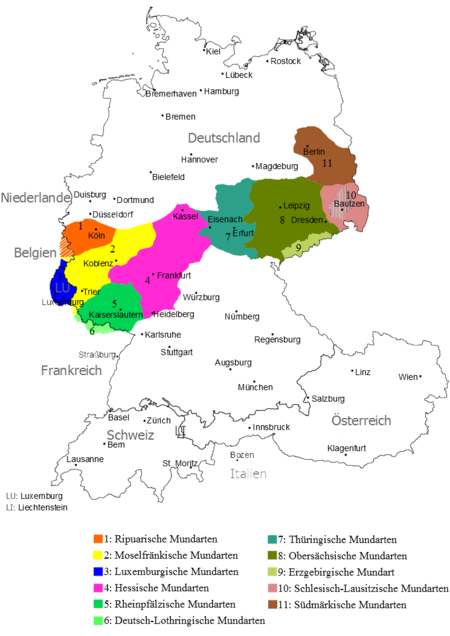Dialects in Saxony-Anhalt
overview
In Saxony-Anhalt today, a regionally colored High German is spoken, which is characterized by the Thuringian-Upper Saxon dialect in the southern parts of the country , but also has a variety of specific expressions from the Mark-Brandenburg language .
A typical regiolect is the Anhalt dialect ("Das Anhaltische"), which is cultivated in literature as prose and also as poetry to the present day . It encompasses the region of the former principalities and later duchies of Anhalt-Dessau , Anhalt-Köthen , Anhalt-Bernburg with temporarily Anhalt-Plötzkau as well as partly to the north of Anhalt-Zerbst . To the north, the Low German substrate and the turns from the Mark-Brandenburg region increase. It is very rare to find dialects among older people that were originally spoken in the regions instead of Anhalt .
As far as these dialects are concerned, the state is in a transition zone:
In the north of the country around Magdeburg and in the Altmark , Low German was originally (and is rarely still) spoken. Specifically, in the western Magdeburg Börde including the city of Magdeburg it is the East Westphalian dialect of the Lower Saxon language , east of the Elbe and in the Altmark it is the Märkisch-Brandenburg dialect of the East Low German language , sometimes also referred to as Altmärkisch .
An imaginary dividing line exists roughly along the towns of Wernigerode - Aschersleben - Schönebeck - Roßlau . This line is popularly called the ik-i line . Central German dialects are spoken south of it . West of the Saale it is Thuringian, east of it is Upper Saxon. The dialects of Saxony-Anhalt belong to the so-called "Appel dialects". For example, a Dessau dialect speaker says “I”, but instead of the word “apple”, he uses the unshifted “Appel”.
Alexander Kluge describes in his work “Chronicle of Emotions” in the part “The uncanny of time. Pictures from my hometown "the situation in Halberstadt:" ... between the lower town and the upper town there was a language border between Platt, the lower class language, and the upper class language Magdeburg-Thuringian - a class boundary. "
The Mansfeld is a dialect that only to the region Hettstedt - Mansfeld and Eisleben relates. In the so-called Grunddörfen (located between Eisleben and Helbra), this dialect is still very pronounced in its original form.
The pronouncedly differentiated pronunciation of the G sound in the region is striking : They say the Magdeburgians speak the G in five different ways, but G is not included!
These five types occur, for example, in the phrase "Vogelgesang in Magdeburg".
(Say: Voreljesank in Machteburch. The “r” here does not stand for a “rolled” sound, but for a fricative like the Dutch “g”, the first ch is on the soft palate, the second “in front” (on the hard palate ) to speak: [ ˈfoɣəljɛˌzaŋk ɪn ˈmaxtəˌbɔɐ̯ç ])
Overall, based dialect continuum in Saxony-Anhalt so on a five-part speech substrate : In the north ( Altmark ) North Maerkisch , south of it ( Borde ) Eastphalian , further south ( Anhalt ) anhaltisch , in the region Halle hallensisch and in the south and southwest (room Zeitz, Weißenfels, Querfurt, Mansfeld, Harzgerode) Thuringian .
The vocabulary of the dialects of the northern part of the state is recorded and described in the Middle Elbian dictionary . The Thuringian parts of the country are recorded in the Thuringian dictionary .
Individual evidence
- ↑ Georg Müller: Mei Anhalt, where I am. Dialect stories and poems. Compiled and edited by Gunnar Müller-Waldeck . Anhalt Edition, Dessau 2009, ISBN 978-3-936383-15-7 .
- ↑ Heribert Pistor: De Rickfahrkoarte or: Nochwas uff Aanhalt'sch. Hundreds of dialect poems in Anhalt dialect. Anhalt Edition Dessau, Dessau-Roßlau 2018, ISBN 978-3-936383-29-4 .

